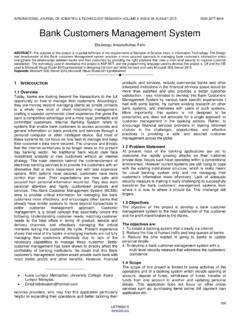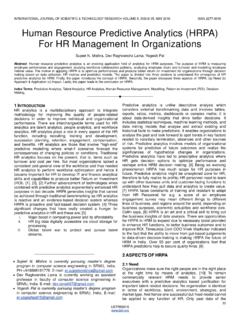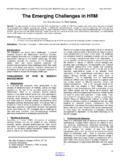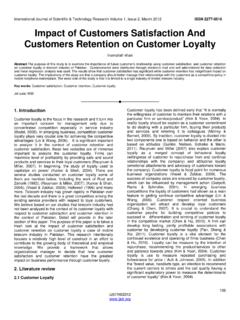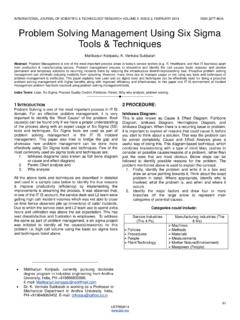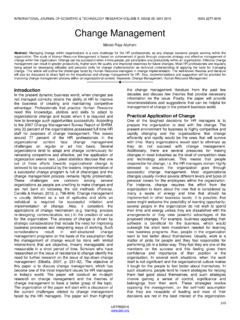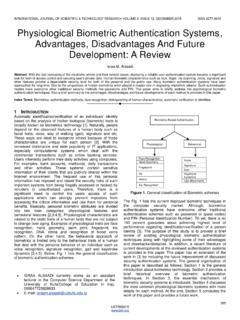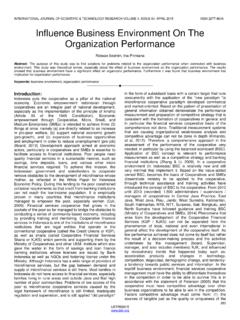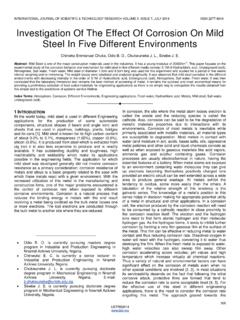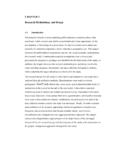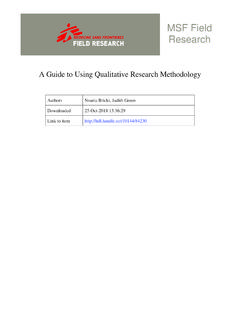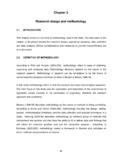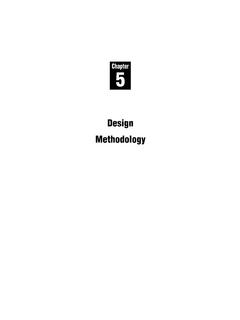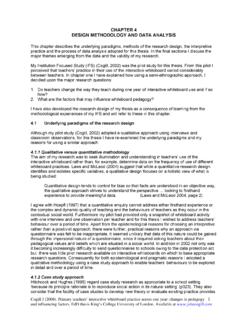Transcription of INTERNATIONAL JOURNAL OF SCIENTIFIC & TECHNOLOGY …
1 INTERNATIONAL JOURNAL OF SCIENTIFIC & TECHNOLOGY research VOLUME 4, ISSUE 04, APRIL 2015 ISSN 2277-8616 180 IJSTR 2015 implementation Of 5S methodology In The Small Scale Industry: A Case Study R. S. Agrahari, Dangle, Abstract: 5S is a basic foundation of Lean Manufacturing systems. It is a tool for cleaning, sorting, organizing and providing the necessary groundwork for workpiece improvement. This paper dealt with the implementation of 5S methodology in the small scale industry. By following the 5S methodology , it shows significant improvements to safety, productivity, efficiency and housekeeping. The improvements before and after 5S implementation is shown by pictures in the paper. It also intends to build a stronger work ethic within the management and workers who would be expected to continue the good practices.
2 Keywords: 5S, productivity, Lean Manufacturing, Analytical Hierarchy Process (AHP). 1 INTRODUCTION 5 S is an approach to organize, order, clean, standardize and continuously improve a work area. 5S is not just about housekeeping, It is one of the efficiently working tools of Lean Manufacturing. The program gets its name from five activities beginning with the letter S, which were derived from five Japanese words. The words are Seiri, Seiton, Seiso, Seiketsu and Shitsuke, which when translated mean Sort, Set in Order, Shining, Standardize and Sustain, respectively. Sort helps to remove all unneeded items: only what is needed stays. Set establishes locations and quantities needed for efficient operation. Shine represent cleaning through inspection. Standardize implements visual displays and controls.
3 Sustain helps to keep the organization effort in place through training and total employee involvement. The aim of this paper is to implement 5S methodology and measure the performance improvement in Auto Pvt. Ltd. A small scale industry situated at Satpur ( ), Nasik. 5S is a lean manufacturing tool for cleaning, sorting, organizing and providing necessary ground work for work place improvement. 5S is already selected using Analytic Hierarchy Process (AHP), a multi criteria design making (MCDM) tool by considering different criteria for case company. AHP is a problem solving framework based on the innate human ability to make sound judgement about small problem. It is a quantitative technique use to facilitate decision that involves multiple competing criteria. 2 PROBLEM STATEMENT The small scale industry occupy a prominent position of unique importance in economy of India.
4 It has emerged as powerful tool in providing relatively larger employment next to agriculture. Global markets are continuously changing and demanding product of high quality and low cost. In India, the survival and the growth of small scale industry largely depends on its ability to innovate, improve operational efficiency and increase productivity. Many business have been trying to adopt new business initiative in order to stay alive in the new competitive market place. Lean manufacturing is one of these initiatives that focuses on the cost reduction by eliminating wastes(non value added activities). research at Lean Enterprise research Centre (LERC) indicates that for a typical manufacturing company the ratio for activity could be broken down as value added activity-5%, non value added activity (waste)-60% and necessary non value added activity-35%.
5 This implies that upto 60% of the activity at a typical manufacturing company could potentially be eliminated. All Lean manufacturing tools are not possible to implement in small scale industry because of limited resources, finance, infrastructure, work force etc. The 5S, potential Lean manufacturing tool selected through AHP considering different criteria is to be applying for performance improvement of case company. Definition of 5Ms:- A manufacturing quality problem solving model or tool that is based on using five factors of manufacturing namely Manpower, Machine, Medium, Mission and Management to gain desired outcomes. Definition of 5S:- A philosophy based on five Japanese terms utilized for creating and sustaining a well organized workplace that is more efficient and productive in operation.
6 3 LITERATURE REVIEW This section reviews the current literature on Len and 5S practices. It explores the concept of 5S and its implementation in a workplace. The basic foundation and its philosophy highlight the significance of 5S. Lean Manufacturing The roots of Lean manufacturing concepts are derived from the production system of the automobile manufacturing industry. The first cars of master craftsmen were built using a wide range of skills and abilities but with low efficiency and a t a high cost. Later Henry Ford documented these limitations _____ Ravindra S. Agrahari& Priyanka A. Dangle is currently pursuing Bachelors degree program in Mechanical Engineering in Pune University, India, PH-+91 9096193933, 9260467422. E-mail: Prof. is Professor of Mechanical Engineering in , Sapat s COE, Nasik, MS, India.
7 E-mail: INTERNATIONAL JOURNAL OF SCIENTIFIC & TECHNOLOGY research VOLUME 4, ISSUE 04, APRIL 2015 ISSN 2277-8616 181 IJSTR 2015 and broke the assembly process down into 30 second tasks, which were performed almost a thousand times a day (Krafeik,1988). Later the concept of teamwork create the Toyota Production System (TPS) by merging the skill of master craftsmen with the knowledge of Ejji Toyota and Taiichi Ohnos for the first time in 1990, Womack, Jones and Roos famous book wrote about the Lean Manufacturing concept. All service or production industries can implement Lean Manufacturing to reduce & eliminate waste in a manner that is simple, feasible, reliable, cost effective and synergistic with other programs. Lean Manufacturing defines waste as anything that adds cost to the product, without adding value that the customer would pay for (Pirraglia, Saloni & Van Dyk, 2009).
8 Therefore lean practices help improve the product or information flow through the process, shorten the lead times, support continuous improvement and as a complete philosophy, help reduce defects of the products or information (Marchwinski, 2007). Cutting cost is not only the aspect that Lean manufacturing is concerned with (Pirraglia, et. al, 2009). It is also used to get big benefits using less human capital, space, monetary capital and time, which free resources to increase available capacity (Womack & Jones, 1991). 5S-The Beginning of Lean 5S is the one of the essential steps in motion and bring about a flourishing Lean culture (Cooper. Et. al 2007). It provides the ground work and the workplace as a way to modify how people approach their planned future state. Van Pattern (2006) and Samuels (2009) concur that 5S is often understood as a simple strategy to clean the shop fl;oor but it can be potent application for developing a successful business for deploying a new standard of workplace practices.
9 When everything has a place and there is a position for all things, a 5S program will serve for supporting a clear picture of the workplace Fig. 1. The Schematic Diagram of 5S principles. (Bullington,2003). Many organizations not only apply 5S as a first step of going Lean but also emphasizes on the removal of wait time and no value added acitivity. In a 5S workplace, tools kept on a shadow board are obvious at a distance and time spent looking for items is greatly reduced (Howell,2009). 4 5 S THE PROCESS Steps of the 5S process are as follows: Sort (Seiri) Sorting is the first step-removing all surplus items from the work center which are not needed for the immediate continual operations (Hough,2008). At this stage it is decided what is really needed and what is not.
10 Any item or tool that is unaccounted out of place or unnecessary needs to be clearly documented. A red tag is a document made on red colored paper that is attached to potential junk items in a workplace. The items are stored temporarily until assignable action can be undertaken, it is usually the starting point of a 5S exercise. Items are red tagged with the best description of use or placement recorded on it. All red tagged articles are moved to a temporary holding area, and that area clearly is identified as the red tag or Seiri area. Equipment or anything else that is not of use, should be discarded as refuse to be thrown out (Howell, 2009). To implement the first step of 5S, a production team needs to know what material is used when the material in storage are to used where the required materials are, and what the users requirement are (Hirano 1993).
